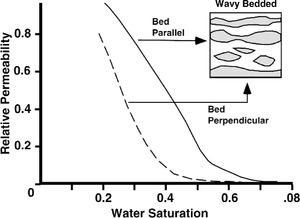Formation-scale migration pathways
| Exploring for Oil and Gas Traps | |

| |
| Series | Treatise in Petroleum Geology |
|---|---|
| Part | Critical elements of the petroleum system |
| Chapter | Migration of petroleum |
| Author | Martin D. Matthews |
| Link | Web page |
| Store | AAPG Store |
Flow of an immiscible phase through a series of beds does not proceed uniformly but occurs preferentially through beds of higher permeability when possible. It is dependent on the capillary properties of individual beds, the proportion of higher- to lower-permeability beds, and spatial relationships of beds to the principal flow directions (bed-parallel and bed-perpendicular). These factors are similar to the factors reservoir engineers use to characterize reservoir heterogeneity. They are, however, more difficult to assess because of the uncertainty of the characteristics of low-permeability rocks. The knowledge base is currently undergoing rapid change.
Bed orientation control of flow
The effect of bedding geometry on permeability direction and magnitude is significant. The table below shows how bedding orientation controls flow of hydrocarbons during migration.
| If bed orientation is… | then the flow is… |
|---|---|
| parallel to the flow direction | principally controlled by the most permeable units |
| perpendicular to the flow direction | principally controlled by the least permeable units |
| randomly aligned to the flow direction | not preferentially focused |
Bed-parallel vs. bed-perpendicular flow

The crosspiot in Figure 1 shows the difference in relative permeability at varying water saturations for bed-parallel vs. bed-perpendicular multiphase fluid flow in a wavy bedded rock. The water saturations need to be much lower in bed-perpendicular flow to achieve the same relative permeability. The flow within a bed is a function of the proportions of end-member lithologies, their permeability and capillary pressures, and the orientation of the beds to the direction of the flow.
See also
- Migration pathways
- Defining migration pathways from source to trap
- Migration distance: vertical and lateral
- Migration rate
References
- ↑ Ringrose, S. P., and P. W. M. Corbett, 1994, Controls in two phase fluid flow in heterogeneous sandstones, geofluids, in Parnell, J., ed., Origin, Migration, and Evolutions of Fluids in Sedimentary Basins: Geological Society Special Publication no. 78, p. 141–150.